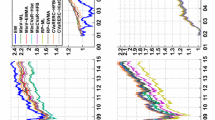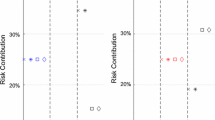Abstract
We study the equal risk contribution (ERC) investment strategies exploring how these portfolios perform relative to traditional risk-only (minimum variance portfolio), risk–return (Markowitz portfolio) and naïve (1/n) investment schemes when expanding the asset class universe. We propose a combinatorial mechanism to expand the investment universe of all feasible ERC portfolios and then combine them, thus realizing an ERC efficient frontier consistent with the mutual fund separation theorem (Merton in J Financ Quant Anal 7:1851–1872, 1972). In doing this, we mitigate the out-of-sample estimation error in portfolio weights and better diversify asset allocation against unpredictable extreme events. Simulation, bootstrapping and empirical experiments indicate that the corresponding tangency portfolio, computed through the regression-based approach introduced in Britten-Jones (J Finance 54:655–671, 1999), offers better risk-adjusted performance relative to risk-only, risk–return-based competitors as well as the 1/n strategy.


Similar content being viewed by others
Notes
For a comprehensive list of key studies on RP, see Roncalli (2013).
Any locally optimal point of a convex problem is in fact (globally) optimal.
Computationally, the optimization problem is solved by finding the global minimum variance portfolio under the following constraints:
\(\left\{ {\begin{array}{*{20}l} {\sum\nolimits_{i = 1}^{n} {a_{i} } \ln w_{i} \ge c} \hfill \\ {{\mathbf{1}}^{T} = 1} \hfill \\ {0 \le w \le 1} \hfill \\ \end{array} } \right.\)
with c be an arbitrary constant (see Roncalli 2013). In this case, the problem is similar to a variance minimization subject to the same constraints in Eqs. (5) and (6).
See Lemma 1 and Proposition 1 of Ukhov (2006).
Merton (1972) proves that given n risky assets, there are two mutual funds formed with these assets, such that all risk-averse (mean–variance utility maximizers) individuals will be indifferent in choosing between portfolios from among the original n assets or from these two funds.
The two scenarios correspond to the numerical example used in Ukhov (2006), pg. 199.
Summary statistics and correlations are computed over the entire time period 1996–2013, as well as in specific sub-periods: 1996–2000 (dot-com bubble); 2001–2007 (great moderation); 2007-2008 (global financial crisis); 2009–2011 (European sovereign debt crisis); 2012–2013 (post-Draghi “whatever it takes” speech).
The weights \(v\) assigned to each observation are calculated by the following formula: \(v_{i} = \frac{{\exp^{{\left( {i - T} \right)\delta }} }}{{\mathop \sum \nolimits_{i = 1}^{T} \exp^{{\left( {i - T} \right)\delta }} }}\) where \(\delta\) is equal to \(\frac{3}{T}\), which corresponds approximately to a decay factor \(\lambda = 0.95\). To test the robustness of \(\varSigma\) we performed a bootstrap procedure with 10,000 draws from the rolling window containing 60 monthly observations and based on these values we recomputed the \(\varSigma\) matrix and its corresponding weights vector for each draw. We then used the vector of average weights based on the resampling to rebalance the portfolios and compared the results with original weights and returns. Our results, not reported in the text but available upon request, confirmed the robustness of the \(\varSigma\) estimation with tight differences in weights and returns between original and bootstrapped portfolios.
However, we leave the door open for better return predictions using emerging statistical approaches, such as machine learning. This issue will be the next step in our research agenda.
To use as much data points as possible and assign more importance to recent observations, we computed the standard deviation of the ERC portfolios using their previous 23 daily observations, namely approximately reflecting the last month (in business days).
Interestingly, the findings Leote de Carvalho et al. (2012) are consistent with Fama and French (2004): Using ten value-weighted beta-sorted portfolios of US equities over the period 1928–2003, the authors prove that expected returns seem to be the same, no matter what the beta over the long run. It follows that, if expected returns are equal for all stocks, minimum variance is the portfolio that maximizes the ex ante Sharpe ratio.
We used 252 daily observations to compute CAPM-betas to proceed with the equally weighted beta-sized ERC portfolios.
References
Asness, C., A. Frazzini, and H.L. Pedersen. 2012. Leverage aversion and risk parity. Financial Analysts Journal 68 (1): 47–59.
Blume, M., and I. Friend. 1975. The asset structure of individual portfolios and some implications for utility functions. Journal of Finance 30 (2): 585–603.
Britten-Jones, M. 1999. The sampling error in estimates of mean-variance efficient portfolio weights. Journal of Finance 54 (2): 655–671.
Choueifaty, Y., and Y. Coignard. 2008. Toward maximum diversification. The Journal of Portfolio Management 35 (1): 40–51.
Clarke, R., R. de Silva, and S. Thorley. 2013. Risk parity, maximum diversification, and minimum variance: An analytic perspective. The Journal of Portfolio Management 39 (3): 39–53.
de Jong, M. 2018. Portfolio optimisation in an uncertain world. Journal of Asset Management 19 (4): 216–221.
DeMiguel, V., L. Garlappi, and R. Uppal. 2009. Optimal versus naïve diversification: How inefficient is the 1/n portfolio strategy? Review of Financial Studies 22 (5): 1915–1953.
Fama, E.F., and K.R. French. 2004. The capital asset pricing model: Theory and evidence. The Journal of Economic Perspectives 18 (3): 25–46.
Gillen, B. J. 2016. Subset optimization for asset allocation. Pasadena, US: California Institute of Technology, Social Science Working Paper no. 1421.
Goyal, A., and I. Welch. 2008. A comprehensive look at the empirical performance of equity premium prediction. Review of Financial Studies 21 (4): 1455–1508.
Green, R.C., and B. Hollifield. 1992. When will mean-variance portfolios be well diversified? Journal of Finance 47 (5): 1785–1809.
Inker, B. 2011. Dangers of risk parity. The Journal of Investing 20 (1): 90–98.
Jobson, J.D., and B. Korkie. 1980. Estimation for Markowitz efficient portfolios. Journal of American Statistical Association 75 (371): 544–554.
Jurczenko, E., T. Michel, and J. Teiletche. 2013. Generalized risk-based investing. SSRN Electronic Journal. https://doi.org/10.2139/ssrn.2205979.
Kan, R., and G. Zhou. 2007. Optimal portfolio choice with parameter uncertainty. Journal of Financial and Quantitative Analysis 42 (3): 621–656.
Kaya, H., and W. Lee. 2012. Demystifying risk parity. New York: Neuberger Berman LLC.
Kohler, A., and H. Wittig. 2014. Rethinking portfolio rebalancing: Introducing risk contribution rebalancing as an alternative approach to traditional value-based rebalancing strategies. Journal of Portfolio Management 40 (3): 34–46.
Laurent, S., J.V. Rombouts, and F. Violante. 2012. On the forecasting accuracy of multivariate GARCH models. Journal of Applied Econometrics 27 (6): 934–955.
Lee, W. 2011. Risk-based asset allocation: A new answer to an old question? Journal of Portfolio Management 37 (4): 11–28.
Lee, W. 2014. Constraints and innovations for pension investment: The cases of risk parity and risk premia investing. Journal of Portfolio Management 40 (3): 12–19.
Leote de Carvalho, R., X. Lu, and P. Moulin. 2012. Demystifying equity risk–based strategies: A simple alpha plus beta description. Journal of Portfolio Management 38 (3): 56–70.
Lindberg, C. 2009. Portfolio optimization when expected stock returns are determined by exposure to risk. Bernoulli 15 (2): 464–474.
Maillard, S., T. Roncalli, and J. Teiletche. 2010. The properties of equally-weighted risk contributions portfolios. Journal of Portfolio Management 36 (4): 60–70.
Markowitz, H. 1952. Portfolio selection. The Journal of Finance 7 (1): 77–91.
Merton, R. 1972. An analytic derivation of the efficient portfolio frontier. Journal of Financial and Quantitative Analysis. 7 (4): 1851–1872.
Merton, R.C. 1980. On estimating the expected return on the market. Journal of Financial Economics 8 (4): 323–361.
Michaud, R. 1989. The Markowitz optimization enigma: Is ‘optimized’ optimal? Financial Analysts Journal 45 (1): 31–42.
Qian, E. 2011. Risk parity and diversification. The Journal of Investing 20 (1): 119–127.
Roncalli, T. 2013. Introduction to risk parity and budgeting., Financial mathematics series London: Chapman & Hall/CRC.
Ukhov, A.D. 2006. Expanding the frontier one asset at a time. Finance Research Letters 3 (3): 194–206.
Zakamulin, V. 2015. A test of covariance-matrix forecasting methods. Journal of Portfolio Management 41 (3): 97–108.
Author information
Authors and Affiliations
Corresponding author
Additional information
Publisher's Note
Springer Nature remains neutral with regard to jurisdictional claims in published maps and institutional affiliations.
Appendix: Asset class benchmarks
Appendix: Asset class benchmarks
In this Appendix, we report summary statistics and correlations computed for the 8 indices we used as benchmarks for the asset class universe used to realize ERC, GMV, MV and 1/n portfolios. Statistics and correlations are computed over different time intervals.
Tables 7 and 8 report, respectively, summary statistics and correlation structures computed for different time intervals over the entire period from January 1996 to August 2013 of the 8 asset classes used in forming portfolios in our empirical analysis. We first note, as expected, high correlations between equity-based indices especially during stress scenarios (2007–2008 and 2009–2011). Despite the increasing integration of equity markets as shown by correlation structures computed for different time periods reported in the table, European and US equity indices have been notwithstanding included in the dataset, since they are representative of the two main equity markets taken into account by portfolio managers.
The Euro government bonds market index plays an important role in portfolio construction, as it tends to act as “portfolio stabilizer” for two reasons. First, as given in Table 7, the index exhibits low volatility also across time with a range of 1.1–1.4%. Second, the index contributes substantially to the portfolio diversification, as proven by looking at correlations with equity markets (except for the periods 1996–2000 and 2012–2013). Similarly, the US Corporate Bond Market index contributes to better diversifying portfolios, as it shows stable returns (Table 7) and sometimes negative correlations (Table 8). However, the index differs from government bond dynamics, especially during periods of corporate default clustering as in 2007–2011, when returns dynamics were mostly driven by credit spreads.
High-Yield and Emerging Market bond indices are two important asset classes, especially in the short run. While descriptive statistics and correlations show that the two indices seem to deliver the same risk-adjusted profile with high correlations, in the short run they may differ significantly in terms of risk and returns (see, e.g., Table 7, 1996–2000 and 2012–2013). Another interesting feature of the High-Yield bond index concerns the high correlation with equity markets with spikes during extreme negative returns of equities, as was the case during the period from 2007 to 2008. This pattern is contrasting with correlations between Investment Grade bonds and equity markets that remained low during times of negative equity returns (see correlations with the Euro, the US and Emerging Markets equity indices during the period 2007–2008).
The emerging market bond index shows higher correlations relative to equity than relative to fixed income, and the Emerging Markets equity index has shown increasing correlations with the Euro and US equity markets as capital market integration became substantial across countries.
Finally, data in tables confirm that commodity acts as an important asset class portfolio diversifier due to its low or negative correlation with traditional asset classes over the long term. However, during periods of economic downturn, such as in the late 2000s, commodities’ correlation with other asset classes, especially equity, tended to sharply increase. Note that commodity delivered equity-like performance over the long run, albeit with significant variations in recent decades. Specifically, such an asset class experienced the best performance relative to equity and fixed income during times of high inflation (2001–2007), thus helping in mitigating the negative effects of inflation risk.
Rights and permissions
About this article
Cite this article
Savona, R., Orsini, C. Taking the right course navigating the ERC universe. J Asset Manag 20, 157–174 (2019). https://doi.org/10.1057/s41260-019-00117-5
Revised:
Published:
Issue Date:
DOI: https://doi.org/10.1057/s41260-019-00117-5




